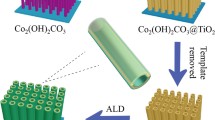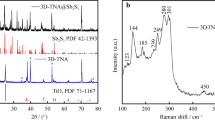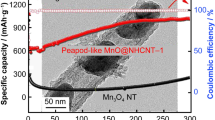Abstract
In order to optimize the electrode system of lithium–ion batteries (LIBs) for problems like lithium-ion diffusion, electron transport, and large volume change during cycling processes, a novel three-dimensional (3D) hybrid Fe2O3 nanotube array anode coated by polypyrrole (Fe2O3@PPy) is synthesized via a sacrificial template-accelerated hydrolysis method followed by a chemical vapor-phase polymerization process. In the hollow core–shell nanostructures, the conducting PPy layer could not only facilitate the electron transport, but also force the core to expand inward into the hollow space, which allows for free volume expansion of the Fe2O3 without mechanical breaking. Besides, the static outer surface is contributed to form a stable solid electrolyte interface film. As a result, the integration of 3D hybrid nanostructure electrode is capable of retaining a high capacity of 665 mA h g−1 after 150 cycles with a coulombic efficiency of above 97 %, revealing better cycling properties compared with bare Fe2O3 nanotube arrays’ anode. This nanoengineering strategy is proven to be an ideal candidate for the development of high-performance anode for LIBs.










Similar content being viewed by others
References
Guo JX, Chen L, Wang GJ, Zhang X, Li FF (2014) In situ synthesis of SnO2-Fe2O3@polyaniline and their conversion to SnO2-Fe2O3@C composite as fully reversible anode material for lithium-ion batteries. J Power Sour 246:862–867
Jiang SH, Yue WB, Gao ZQ, Ren Y, Ma H, Zhao XH, Liu YL, Yang XJ (2013) Graphene-encapsulated mesoporous SnO2 composites as high performance anodes for lithium-ion batteries. J Mater Sci 48:3870–3876. doi:10.1007/s10853-013-7189-9
Xu WW, Zhao KN, Niu CJ, Zhang L, Cai ZY, Han CH, He L, Shen T, Yan MY, Qu LB, Mai LQ (2014) Heterogeneous branched core-shell SnO2-PANI nanorod arrays with mechanical integrity and three dimensional electron transport for lithium batteries. Nano Energy 8:196–204
Liu H, Wang GX, Park J, Wang JZ, Liu HK, Zhang C (2009) Electrochemical performance of α-Fe2O3 nanorods as anode material for lithium-ion cells. Electrochim Acta 54:1733–1736
Wang W, Bu FX, Jiang JS (2015) Porous TiO2 coated α-Fe2O3 ginger-like nanostructures with enhanced electrochemical properties. Mater Lett 139:89–92
Chen MH, Liu JL, Chao DL, Wang J, Yin JH, Lin JY, Fan HJ, Shen ZX (2014) Porous α-Fe2O3 nanorods supported on carbon nanotubes-graphene foam as superior anode for lithium ion batteries. Nano Energy 9:364–372
Wang RH, Xu CH, Sun J, Gao L, Lin CC (2013) Flexible free-standing hollow Fe3O4/graphene hybrid films for lithium-ion batteries. J Mater Chem A 1:1794–1800
Wu Z-S, Ren WC, Wen L, Gao LB, Zhao JP, Chen ZP, Zhou GM, Li F, Cheng H-M (2010) Graphene anchored with Co3O4 nanoparticles as Anode of lithium ion batteries with enhanced reversible capacity and cyclic performance. ACS Nano 4:3187–3194
Jin YH, Li Wang, Shang YM, Gao J, Li JJ, He XM (2015) Facile synthesis of monodisperse Co3O4 mesoporous microdisks as an anode material for lithium ion batteries. Electrochim Acta 151:109–117
Szabo DV, Kilibarda G, Schlabach S, Trouillet V, Bruns M (2012) Structural and chemical characterization of SnO2-based nanoparticles as electrode material in Li-ion batteries. J Mater Sci 47:4383–4391. doi:10.1007/s10853-012-6292-7
Cao F, Pan GX, Xia XH, Tang PS, Chen HF (2014) Synthesis of hierarchical porous NiO nanotube arrays for supercapacitor application. J Power Sour. 264:161–167
Chen J, Xu LN, Li WY, Gou XL (2005) α-Fe2O3 nanotubes in gas sensor and lithium-ion battery applications. Adv Mater 17:582–586
Su QM, Xie D, Zhang J, Du GH, Xu BS (2013) In situ transmission electron microscopy observation of the conversion mechanism of Fe2O3/graphene anode during lithiation-delithiation processes. ACS Nano 7:9115–9121
Zou MZ, Li JX, Wen WW, Chen LZ, Guan LH, Lai H, Huang ZG (2014) Silver-incorporated composites of Fe2O3 carbon nanofibers as anodes for high-performance lithium batteries. J Power Sour 270:468–474
Wang BB, Wang G, Wang H (2015) Synthesis and electrochemical investigation of hollow hierarchical metal oxide microspheres for high performance lithium-ion batteries. Electrochim Acta 156:1–10
Fan X, Dou P, Jiang AN, Ma DQ, Xu XH (2014) One-step electrochemical growth of three-dimensional Sn-Ni@PEO nanotube array as a high performance lithium-ion battery anode. ACS Appl Mater Interfaces 6:22282–22288
Zeng WQ, Zheng FP, Li RZ, Zhan Y, Li YY, Liu JP (2012) Template synthesis of SnO2/α-Fe2O3 nanotube array for 3D lithium ion battery anode with large areal capacity. Nanoscale 4:2760–2765
Lamberti A, Garino N, Sacco A, Bianco S, Chiodoni A, Gerbaldi C (2015) As-grown vertically aligned amorphous TiO2 nanotube arrays as high-rate Li-based micro-battery anodes with improved long-term performance. Electrochim Acta 151:222–229
Wang B, Qiu TF, Li XL, Luo B, Hao L, Zhang YB, Zhi LJ (2015) Synergistically engineered self-standing silicon/carbon composite arrays as high performance lithium battery anodes. J Mater Chem A 3:494–498
Wu H, Chan G, Choi JW, Ryu I, Yao Y, Mcdowell MT, Lee SW, Jackson A, Yang Y, Hu LB, Cui Y (2012) Stable cycling of double-walled silicon nanotube battery anodes through solid-electrolyte interphase control. Nat Nanotech 7:310–315
Balaya P, Li H, Kienle L, Maier J (2003) Fully reversible homogeneous and heterogeneous Li storage in RuO2 with high capacity. Adv Funct Mater 13:621–625
Hu J, Li H, Huang XJ, Chen LQ (2006) Improve the electrochemical performances of Cr2O3 anode for lithium ion batteries. Solid State Ion 177:2791–2799
Han F, Li D, Li WC, Lei C, Sun Q, Lu AH (2013) Nanoengineered polypyrrole-coated Fe2O3@C multifunctional composites with an improved cycle stability as lithium-ion anodes. Adv Funct Mater 23:1692–1700
Fu LJ, Liu H, Li C, Wu YP, Rahm E, Holze R, Wu HQ (2006) Surface modifications of electrode materials for lithium ion batteries. Solid State Sci 8:113–128
Li S, Qin XY, Zhang HR, Wu JX, He Y-B, Li BH, Kang FY (2014) Silicon/carbon composite microspheres with hierarchical core-shell structure as anode for lithium ion batteries. Electrochem Commun 49:98–102
Gowda SR, Reddy ALM, Shaijumon MM, Zhan XB, Ci LJ, Ajayan PM (2011) Conformal coating of thin polymer electrolyte layer on nanostructured electrode materials for three-dimensional battery applications. Nano lett 11:101–106
Yoon T, Chae CJ, Sun Y-K, Zhao X, Kung HH, Lee JK (2011) Bottom-up in situ formation of Fe3O4 nanocrystals in a porous carbon foam for lithium-ion battery anodes. J Mater Chem 21:17325–17330
Xu WW, Zhao KN, Niu CJ, Zhang L, Cai ZY, Han CH, He L, Shen T, Yan MY, Qu LB, Mai LQ (2014) Heterogeneous branched core-shell SnO2-PANI nanorod arrays with mechanical integrity and three dimensional electron transport for lithium batteries. Nano Energy 8:196–204
Cui LF, Shen J, Cheng FY, Tao ZL, Chen J (2011) SnO2 nanoparticles@polypyrrole nanowires composite as anode materials for rechargeable lithium-ion batteries. J Power Sour 196:2195–2201
Nyholm L, Nystrom G, Mihranyan A, Stromme M (2011) Toward flexible polymer and paper-based energy storage devices. Adv Mater 23:3751–3769
Liu JL, Zhou WW, Lai LF, Yang HP, Lim SH, Zhen YD, Yu T, Shen ZX, Lin JY (2013) Three dimensionals α-Fe2O3/polypyrrole (Ppy) nanoarray as anode for micro lithium ion batteries. Nano energy 2:726–732
Song T, Xia JL, Lee J-H, Lee DH, Kwon M-S, Choi J-M, Wu J, Doo SK, Chang H, Park W, Zang DS, Kim H, Huang YG, Hwang K-C, Rogers JA, Paik U (2010) Arrays of sealed silicon nanotubes as anodes for lithium ion batteries. Nano Lett 10:1710–1716
Lotfabad EM, Kalisvaart P, Kohandehghan A, Cui K, Kupsta M, Farbod B, Mitlin D (2014) Si nanotubes ALD coated with TiO2, TiN or Al2O3 as high performance lithium ion battery anodes. J Mater Chem A 2:2504–2516
Desai UV, Xu CK, Wu JM, Gao D (2013) Hybrid TiO2-SnO2 nanotube arrays for dye-sensitized solar cells. J Phys Chem C 117:3232–3239
Liu JP, Li YY, Fan HJ, Zhu ZH, Jiang J, Ding RM, Hu YY, Huang XT (2010) Iron oxide-based nanotube arrays derived from sacrificial template-accelerated hydrolysis: large-area design and reversible lithium storage. Chem Mater 22:212–217
Liu JP, Huang XT, Li YY, Ji XX, Li ZK, He X, Sun FL (2007) Vertically aligned 1D ZnO nanostructures on bulk alloy substrates: direct solution synthesis, photoluminescence, and field emission. J Phys Chem C 111:4990–4997
Lv XX, Deng JJ, Wang J, Zhong J, Sun XH (2015) Carbon-coated α-Fe2O3 nanostructures for efficient anode of Li-ion battery. J Mater Chem A 3:5183–5188
Liu RQ, Li DY, Wang C, Li N, Li Q, Lu XJ, Spendelow JS, Wu G (2014) Core-shell structured hollow SnO2-polypyrrole nanocomposite anodes with enhanced cyclic performance for lithium-ion batteries. Nano Energy 6:73–81
Wu C, Zhang H, Wu YX, Zhuang QC, Tian LL, Zhang XX (2014) Synthesis and characterization of Fe@Fe2O3 core-shell nanoparticles/graphene anode material for lithium-ion batteries. Electrochim Acta 134:18–27
Chen G, Rodriguez R, Fei L, Xu Y, Deng SG, Smirnov S, Luo HM (2014) A facile hydrothermal route to iron(III) oxide with conductive additives as composite anode for lithium ion batteries. J Power Sour 259:227–232
Liang K, Gu TL, Cao ZY, Tang XZ, Hu WC, Wei BQ (2014) In situ synthesis of SWNTs@MnO2/polypyrrole hybrid film as binder-free supercapacitor electrode. Nano Energy 9:245–251
Zhao JF, Zhang SC, Liu WB, Du ZJ, Fang H (2014) Fe3O4/PPy composite nanospheres as anode for lithium-ion batteries with superior cycling performance. Electrochim Acta 121:428–433
Cherian CT, Sundaramurthy J, Kalaivani M, Ragupathy P, Kumar PS, Thavasi V, Reddy MV, Sow CH, Mhaisalkar SG, Ramakrishna S, Chowdari BVR (2012) Electrospun α-Fe2O3 nanorods as a stable, high capacity anode material for Li-ion batteries. J Mater Chem 22:12198–12204
Sun B, Horvat J, Kim HS, Kim W-S, Ahn J, Wang GX (2010) Synthesis of mesoporous α-Fe2O3 nanostructures for highly sensitive gas sensors and high capacity anode materials in lithium ion batteries. J Phys Chem C 114:18753–18761
Shin J-Y, Samuelis D, Maier J (2011) Sustained lithium-storage performance of hierarchical, nanoporous anatase TiO2 at high rates: emphasis on interfacial storage phenomena. Adv Funct Mater 21:3464–3472
Wei DH, Liang JW, Zhu YC, Zhang JJ, Li XN, Zhang KL, Yuan ZQ, Qian YT (2013) Facile formation of graphene-encapsulated α-Fe2O3 nanorice as enhanced anode materials for lithium storage. Electrochim Acta 114:779–784
Lotfabad EM, Kalisvaart P, Kohandehghan A, Karpuzov D, Mitlin D (2014) Origin of non-SEI related conlombic efficiency loss in carbons tested against Na and Li. J Mater Chem A 2:19685–19695
Tian BB, Swiatowska J, Maurice V, Zanna S, Seyeux A, Klein LH, Marcus P (2013) Combined surface and electrochemical study of the lithiation/delithiation mechanism of the iron oxide thin-film anode for lithium-ion batteries. J Phys Chem C 117:21651–21661
Kaya S, Ogasawara H, Nilsson A (2015) Determination of the surface electronic structure of Fe3O4(111) by soft X-ray spectroscopy. Catal Today 240:184–189
Acknowledgements
This work was financially supported by the National Natural Science Foundation of China (No. 51143009 and 51273145).
Author information
Authors and Affiliations
Corresponding author
Rights and permissions
About this article
Cite this article
Yang, H., Yu, X., Meng, H. et al. Nanoengineered three-dimensional hybrid Fe2O3@PPy nanotube arrays with enhanced electrochemical performances as lithium–ion anodes. J Mater Sci 50, 5504–5513 (2015). https://doi.org/10.1007/s10853-015-9096-8
Received:
Accepted:
Published:
Issue Date:
DOI: https://doi.org/10.1007/s10853-015-9096-8




